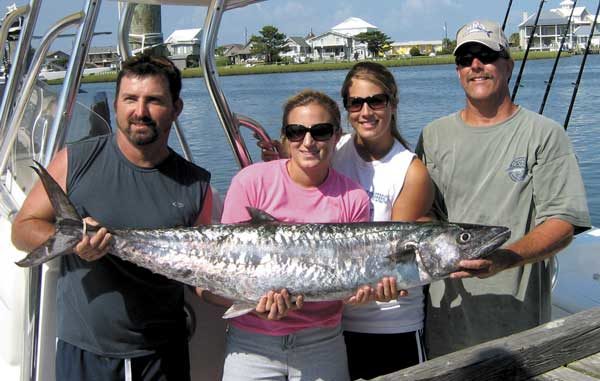
Coastal fishing should be good to excellent for most species this year, but some popular fish face problems.
North Carolina’s saltwater hook-and-line anglers can expect a decent year during 2008 for many popular species, but one of the most pursued fish is in serious decline at central and southern coastal waters, according to the 2007 stock status report of the N.C. Division of Marine Fisheries. To remedy the problem a fishing closure has been proposed for a major N.C. coastal river.
Last year DMF changed some of its definitions of stock status to denote species that hadn’t been classified previously or had stock assessments too unreliable to determine their status. The “overfished” term was changed to “depleted” in some instances because factors other than fishing may have contributed to low populations.
The DMF currently is creating its 2008 stock report.
Black sea bass north of Hatteras, scup, sharks and tautogs were listed in 2007 as “concern” because of status uncertainty. The 2006 black sea bass status report was rejected because overfishing couldn’t be determined. Scup had no recent stock assessment. Sharks were changed to “concern” because of a lack of information about sandbar and blacktip sharks. The 2007 assessment of tautog was unable to say if the stock is overfished, but since the state doesn’t play a role in tautog management, it no longer will be listed. Monkfish were moved from recovering to concern because they’re behind a 10-year rebuilding plan.
Spots dropped from viable to concern because of declines in landings and fishing efforts, and there seems to be an slow decline in Atlantic coast abundance of these fish.
Fishery management plans are being revised for spotted seatrout (specks) and red drum. The National Marine Fisheries Service is readying amendments through its councils and the Atlantic States Marine Fisheries Commission for king mackerel, gray trout and summer flounder, along with some less popular species.
Striped bass
Striped bass are an enigma in North Carolina, with healthy Atlantic Ocean and Albemarle Sound populations but few inland or ocean fish south of Cape Lookout.
The ocean migratory stock, arising mostly from the Chesapeake Bay to New York, has seen recent good winter fishing from Hatteras north during most winters. Albemarle Sound also has big striper numbers that offer spring and summer spawning-run fishing, especially in the Roanoke River.
However, south of Cape Lookout, in the Central/Southern Management Area, stripers are rare, and that population is classified as depleted.
“In the CSMA, striped bass spawn in the Cape Fear, Neuse, and Tar/Pamlico rivers,” said Charlton Godwin, the DMF’s striper expert. “Dams on these rivers have obstructed upstream passage of stripers to their historic spawning habitat, greatly reducing the area available for spawning activity. Also, water flows in all these systems have been greatly altered over the years. Stripers need a certain amount of water flow in order for their eggs to develop. Their eggs are semi-buoyant and must be carried downstream with the currents. If there isn’t enough flow, the fertilized eggs will sink to the bottom of the river and suffocate in the substrate.
“There is a very low level of spawning evidence in the CSMA. We’re trying to protect the adults and get the spawning stock up to a sufficient size to repopulate the river and not rely on stocking as the answer.”
Godwin said fishing pressure also probably has played a role in low striper numbers in the Central/Southern region.
The WRC and DMF have proposed a ban on striper fishing for the Cape Fear River’s inland, joint and coastal waters. That means if the proposed ban is accepted, striper anglers won’t be able to keep fish in any of the river’s waters from the mouth of the Cape Fear at Southport and upstream. Winter fishing for stripers has been popular in the river, especially near Wilmington.
Upstream of the Cape Fear’s Lock and Dam No. 1 is classified as inland waters, while downstream of Lock and Dam No. 1 to the Cape Fear Memorial Bridge at Wilmington is joint waters, and the remainder of the Cape Fear River downstream of the bridge to the Atlantic Ocean is coastal waters. At other N.C. streams, fishing has been allowed at coastal waters, but that no longer would be the case for the Cape Fear River.
The season in the Pamlico Sound and the rest of the CSMA (Neuse, Tar-Pamlico rivers) will be the same as the season in the Albemarle South Management Area — two fish per person per day with an Oct. 1-April 30 season.
A concern of some anglers has been commercial netting of ocean stripers. A method of record keeping in the 2007 stock status report made it appear fewer ocean stripers were being netted. However, a record-keeping anomaly only allowed one-third of the ocean harvest to be recorded.
Godwin said the Atlantic Ocean striperd bass netting quota is about 430,000 pounds, not 186,000 pounds, as listed at the DMF web site.
The quota is split between beach seiners, gill netters and trawlers, each of which should average about 186,000 pounds.
“Beach seiners have a season in December, gill netters get January, and trawlers get February,” Godwin said. “Each gets one-third of the 430,000-pound quota.”
However, if beach seiners have a tremendous year, as occurred in 2005, and go past their quota, they can’t fish the next year until the other two groups catch their quotas.
So only part of the quota is listed in the stock status report because the season extends across two years instead of one year (as records are kept).
Red drum
“Red drum are doing great,” said DMF biologist Lee Paramore. “In updating our fishery management plan, we’ve come pretty close to the targets when we put 2001 restrictions in place.”
That was the year recreational anglers were restricted to keeping one red drum in an 18- to 27-inch-long slot limit to eliminate the harvest of adult spawners. Previously hook-and-line anglers could keep five reds.
“We also implemented a trip limit on the commercial side and made it a bycatch fishery,” Paramore said. “Commercial fishermen also had to land at least 50 percent of other edible finfish.”
Netters only have been able to keep seven red drum per day since 2001, although the DMF’s Red Drum Advisory Committee recommended an increase to 10 redfish per day during 2007.
Paramore said the DMF wants to keep the netters limit at seven fish and will hold public hearings during the next few months to get public comments.
“We think the seven-fish limit is justified,” he said. “The (red drum) stock is in good condition, and we don’t feel like it’s a good time to increase the harvest because we are so near the (FMP) target. But the Marine Fisheries Commission will have to weigh the data against the social needs of what people want to have. We hope to strike a balance and not jeopardize the long-term stock.”
Red drum, the official state fish of North Carolina, are caught in estuaries, sounds and creeks nearly year round and from the Atlantic Ocean, mostly during winter months.
“Landings fluctuate from year to year,” Paramore said. “That’s because most of the (caught) fish in the slot limit come from a single year class.”
Sometimes year classes are strong and sometimes not so strong.
“When we have looked at long-term landings of commericial and rcreational anglers and compared them to previous years, we’ve seen about a 40-percent reduction in the harvest,” Paramore said.
Flounder
Two main varieties of flounders, southern and summer, live in N.C. waters, although a few Gulf flounder are caught each year.
Southern flounder that prefer less salinity are caught mostly at inshore waters — sounds, rivers, creeks marshes and inlets. Summer flounder, which prefer higher salinity water, are mostly caught in the Atlantic Ocean.
The problem for flounder is popularity. Flatfish are one of the top targets for N.C. recreational anglers and receive extensive pressure from commercial netters who use pound and gill nets to trap them. Trawlers also take flounder during the winter.
DMF biologists have noted habitat degredation isn’t a factor in declining flounder numbers, which leaves fishing pressure as the main culprit.
Although recreational anglers landed 361,702 pounds of southern flounder during 2005 (according to Marine Recreational Fishing Statistical Surveys), about 140,000 pounds more than the previous 10-year average, commercial fishermen netted 1,869,864 pounds (500 percent more than the hook-and-line take). But the DMF extended by proclamation last’s fall netting season in Pamlico Sound by two weeks (to Dec. 14, 2007), a season that was set to close Dec. 1.
DMF flounder expert Chris Batsavage said problems caused by a marine grass fouling pound and gill nets during November kept netters from landing many flounder, so the extension was granted. The overall catch, he said, fell within previous year’s numbers.
But no season weight quota exists for southern flounder for commercial or recreational anglers.
“We went to an eight-fish, 14-inch minimum-length rule (for hook-and-line southern flounder anglers) during 2005,” Batasavage said, “but even then, not many people catch an eight-fish limit, so (the regulation) didn’t have a large effect. It might have had an effect on giggers.”
Batsavage said the DMF has three methods to reduce harvests of fish — creel limits, size limits or quotas.
“In 2005 (DMF) put in (net) yardage limits, minimum mesh sizes and closed the season in December,” he said of measures that affected netters. “If anything needs to be done in the future, more limits could be imposed.
“If there’s a problem with a (southern flounder) stock, we need to minimize use by commercial and recreational fishermen.”
Batsavage said the DMF would have to complete its next stock assessment of southern flounder before deciding what measures (if any) to take to help declining stocks.
“Quotas are a possibility (for netters) and size limits could go up, although size-limit changes can create problems with discarded fish,” he said.
For summer (ocean) flounder the news also isn’t good.
Currently overfishing is occurring, and DMF lists the stock as overfished. One difference is summer flounder also are managed by the National Marine Fisheries Service.
“There should be a coastwide stock assesment this summer by NMFS,” Batsavage said. “Right now the issue is the summer stock must be rebuilt by Jan. 1, 2013. In order to reach that goal in the next five years, there will have to be lots of research for commercial and recreational fish.”
Batsavage said it appeared North Carolina will have to reduce its overall catch.
“The commercial (take) already has been reduced through a smaller quota,” he said.
DMF director Dr. Louis Daniel, under a mandate from the NMFS, proclaimed during February the minimum-size for ocean-caught flounder and flounder in the eastern sounds (Pamlico and Albemarle) would increase to 15 1/2 inches. Flounder anglers in the western sounds and rivers still would be able to keep 14-inch flounder and south of Browns Inlet (ocean and inshore fish). The rule began March 1.
The inshore and offshore, ocean flounder limits for N.C. recreational anglers remained at eight fish per person per trip.
Spotted seatrout
With no harsh winters during recent years, spotted seatrout (speckled trout) have grown and flourished in N.C. waters, said DMF biologist Beth Burns.
North Carolina’s last severe winter occurred during 2002-03 and caused large trout kills when coastal creeks, tributaries and portions of some rivers saw ice form on their surfaces.
“The recreational proportion of the harvest really took off during 2006,” she said. “It was the highest recreational harvest of trout (925,612 pounds) we’ve ever recorded.”
As for 2007, Burns said several anglers in Bayboro collect big trout for her.
“I haven’t been there yet, but they said they have more big trout than ever before,” she said.
With another mild winter, speckled trout once again should provide anglers with lots of fish and bigger sizes this spring and summer. But Burns was cautious in predicting too far in the future because of the weather’s unpredictability.
“(The speck resurgence) has been a matter of really perfect environmental conditions for several consecutive years,” Burns said..”The problem with forecasting next year’s success rates is it seems like every 3 to 5 years we take a cold-weather hit.”
Burns said freezes have more to do with where trout are living than any other factor.
“Forty-five-degree water is the critical point,” she said.
If prolonged cold weather occurs and water temperatures drop rapidly, that’s when trout are stunned and sink to the bottom in shallow-water areas.
“If it gradually gets colder, (the fish) have time to move and get to deeper (and warmer) water,” Burns said.
Specks spend most their entire lives in estuarine habitats (creeks, rivers, inlets), although they will venture into the surf during winter.
Commercial landings of specks rose as well, with 306,510 pounds landed in 2006, and 2007 also was a good year. The 2006 figure was about 56,000 pounds higher than the 10-year average, which is a negligible increase.
Burns said she believes overall commercial fishing effort for speckled trout in N.C. waters actually has dropped.
Recreational anglers have noted in some areas, more netting effort is seen when fish are plentiful — which has occurred the last two years.
Even with more nettings, recreational landings of specks in 2006 (925,612 pounds) more than doubled the 10-year average (440,558 pounds from 1997-2006). The number of citation-size (4-pound) specks in 2006 (686) only trailed 1995’s record 695 citations.
Weakfish
Gray trout (weakfish) are in trouble, DMF biologist Lee Paramore said, and no one really seems to know the reason.
“The stock status is depleted for commercial and recreational anglers (Atlantic) coast wide and near an all-time low,” he said.
However, up-and-down cycles seem to be the norm for gray trout, he said.
“Weakfish underwent strict managment changes through the 1990s and responded and went through a rebuilding process for a while,” Paramore said. “But now we’re seeing an extremely low abundance that can’t be explained by fishing pressure. (The problem) seems to be caused by other factors. We don’t know if it’s environmental or predation.”
Average commercial landings of gray trout from 1997-2006 totaled 1,750,903 pounds, but during 2007 netters caught only 362,855 pounds. Recreational landings have remained stable (157,688 pounds during 1997-2006 and 135,922 during 2006), but only one citation (6 pounds) gray trout was recorded in 2006.
Gray trout north of Hatteras seem to be a little healthier. These fish move north during the summer, making biologists believe the problem could be environmental — the fish go to better habitat.
“South of Hatteras, those are our fish, although in winter we see a little stock mixing,” Paramore said. “North of Hatteras the size and age structure is a little better. South of Hatteras fish tend to be smaller.”
But commercial landings have dropped dramatically in the Pamlico Sound and north of Hatteras.
Paramore hinted one reason for the decline of gray trout north of Hatteras and in Pamlico Sound could be increasing numbers of striped bass. A healthy and large ocean striper population is found north of Hatteras while N.C.’s big resident striped bass population lives in Pamlico Sound.
“We are looking at striped bass as a primary culprit,” he said. “The increase in striped bass has correlated with the decrease in weakfish.”
DMF also is examining depressed menhaden populations in some areas.
“If stripers can’t get menhaden (their primary food source), they may be focusing on weakfish,” Paramore said. “But it’s all hypothesis. It seems to be a strong correlation, but it’s hard to determine the exact cause.”
To reduce fishing pressure, the South Atlantic Fishery Managment Council’s weakfish board dropped the daily creel of gray trout from seven to six fish coastwide for recreational anglers and reduced the daily bycatch limit for netters from 300 to 150 pounds.
“I know (DMF) is ready to see (gray trout numbers) trending back upwards,” Paramore said. “It’s unsettlng to see it decline.”
Black sea bass
Anglers may have noticed it’s been more difficult to catch black sea bass of appreciable sizes, especially south of Cape Hatteras. The South Atlantic Fishery Management Council classified the stock as depleted.
“The southern stock is heavily exploited with a decline over time and a 62-percent reduction in harvest is needed,” noted a recent SAFMC report.
Commercial fishing, which lands four times the recreational catch, appears to be a problem. In 2006, rec anglers landed 154,311 pounds while commercial fishermen brought 443,547 pounds to the dock.
North of Hatteras the Northeast Fishery Science Center said the sea bass stock isn’t overfished. However, a review committee rejected the 2006 stock assessment because it said overfishing isn’t known because of discard losses in the commercial industry that remain an “uncertain component.”
The SAFMC dropped the commercial total allowable catch from 8 million pounds in 2006 to 6.5 million pounds in 2007. Yet N.C. regulations still favor commercial fishermen, allowing them to keep fish an inch shorter (11 inches) north of Cape Hatteras than rec anglers and 10-inch fish south of the Cape (recs are restricted to 11-inch fish south of Hatteras).
Dolphin
Because dolphin grow so fast (3.78 mm per day during their first six months) and can reproduce when they reach 23 inches in length, the good news is the stock appears to be stable in the Atlantic.
The DMF stock status report classifies dolphin as viable, based on trends in landings data.
Individual anglers may keep 10 dolphin per day while charter vessels are allowed 60 dolphin per trip.
Recreational catches far outstrip commercial catches of dolphin. During 2006 commercial landings totaled 163,742 pounds while rec anglers boated 5,578,864 pounds.
Although dolphin grow fast and mature early, biologists have concerns about the potential for new pressure as longliners’ catches are more restricted for other species.
North Carolina is under federal management of dolphin with an FMP to maintain the current level of harvest.
King mackerel
Kings are apparently in good shape, and anglers once again should have plenty of fish to target (the DMF classifies king mackerel stocks as viable).
The king mackerel spawning stock biomass is rated above target and fishing mortality is below target, which means fewer fish are being caught. Higher fuel prices for anglers may be one cause of fewer king fishing trips. Certainly N.C. king mackerel tournaments have seen fewer entries because of higher expenses.
North Carolina coastal town economies depend upon a good stock of king mackerel to support the many annual tournaments conducted. Millions of dollars pour into coastal towns because of king tournaments, which range from local to national events.
The catch has been split fairly evenly among commercial and recreational anglers for years, with commercial fishermen taking 1,012,676 pounds and rec anglers catching 1,114,458 in 2006, according to DMF figures.
The largest king mackerel are caught each year from October through November. A large commercial fishery in December lands many fish.
The SAFMC’s Pelagic FMP, which includes king mackerel, has set yearly commercial and recreational quotas, minimum size limits and trip limits, although the year-round season hasn’t been closed.
Spanish mackerel
Spanish mackerel have saved the day of many late spring and summer anglers.
Trolling with Clarkspoons through schools of Spanish have filled ice chests when other fish weren’t so cooperative. That availability should continue through 2008 as the DMF’s stock status report lists Spanish mackerel as viable, its highest rating.
The Spanish rating follows the king mackerel report almost verbatim, except for numbers of fish caught, according to DMF biologist Randy Gregory.
“In the most recent stock assessment the spawning stock biomass is above target and fishing mortality is below target,” he said. “The south Atlantic Spanish mackerel stock is considered healthy and not overfished.”
Commercial and recreational annual landings of Spanish are fairly even as well, with 2006 commercial landings listed at 543,927 pounds and rec catches totaling 463,841 pounds. The commercial take is quota managed, although the recreational season could be closed (it hasn’t been yet) if a total allowable catch is reached.
Spanish mackerel can be found in coastal waters from April through November and prefer water temperatures near 68 degrees.
Recreational anglers may keep 15 fish per trip of at least 12 inches fork length.
The largest Spanish mackerel of the year usually are found at structure with a mile or two of N.C.’s beaches during late April and early May.
Reef fishes
Probably because they are easily targeted and live at well-known, stationary areas of the Atlantic Ocean’s sea bed, reef fishes (73 species) have been hit hard by commercial and sportfishermen for years.
Although the 10-year-average commercial catch of these species from 1997-2006 was 2,666,492 pounds, with those fish sold for $4,462,178 , in 2006, for-profit bottomfishermen landed 2,656,197 pounds and sold them for $5,360,733 — nearly $1 million more than the 10-year average. That indicates higher prices at the dock for reef fish, which translates into more commercial fishing pressure.
Recreational anglers, with increasingly sophisticated equipment have turned to fishing for bottomfish and nearly doubled their catch during the past 10 years. From 1997-2006, they caught 856,145 pounds, yet in 2006, rec anglers landed 1,483,810 pounds.
NMFS has deferred to SAFMC management recommendations to classify stock statuses of these fish and reduce harvests. Of the 73 reef fishes, 17 are overfished, 16 aren’t overfished and the status of the remaining 40 is unknown. Among the 17 overfished species are popular vermilion snapper, red snapper, red porgy, black sea bass, red grouper, snowy grouper, golden tilefish, and gray triggerfish.
In October 2006, SAFMC rules established an annual quota for commercial black sea bass and vermilion snapper and reduced the commercial quota and recreational bag limits for snowy grouper and golden tilefish (one snowy and one golden tilefish per five-fish daily creel), while recreational size limits for black sea bass and vermilion snapper were increased.
A few species already have seasonal closures including wreckfish (Jan. 15-April 15), gag and black grouper (March and April, no sale, bag limit only), red porgy (January-April) and greater amberjack (April, no sale, with a season and quota beginning May 1).
Other measures to reduce reefish harvests, such as Marine Protected Areas that would place certain ocean regions off limits to all fishing, currently are being debated.
Bluefish
Bluefish are in good shape, according to DMF biologist Burns.
The DMF’s assessment rates them as not overfished and overfishing isn’t occurring.
“The last stock assessment said bluefish were no longer overfished for the first time since 2005,” she said. “The 2006 updated report showed a trend of an increasing biomass, so that is a good thing for North Carolina’s future.”
Independent gill-net surveys showed all sizes of bluefish in N.C. waters.
“We’ve even had a few (onshore) bluefish blitzes around Christmas when an east wind pushed baitfish close to the beach,” she said. “Hopefully that will happen more as more as the population comes back.”
Bluefish regulations for rec anglers remain at 15 fish per person per day with only five fish longer than 24 inches total length.
Spot
Although no one would have thought it possible, spot are in trouble.
The 2006 landings for commercial netters (1,364,583 pounds) were about 1 million pounds below the 10-year average. Recreational anglers landed about 250,000 pounds less than the 10-year average (1,188,935 pounds) from 1997-2006. Juvenile abundance indices were among the lowest of the last 15 years during 2006.
These ocean panfish have been the primary catch by number for N.C. recreational anglers. Fall spot “runs” have been popular at the coast for decades, especially at piers. Many anglers visit N.C. beaches and piers during October and November to catch spot with double- and triple-dropper rigs.
Spot are short-lived estuarine-dependent members of the drum family that includes Atlantic croaker, red drum, black drum, spotted seatrout and weakfish.
They spawn in the ocean from late fall to early spring, then wind and currents carry young spot into the upper reaches of the estuaries, where they remain throughout the spring. Adult spot migrate seasonally between estuarine and near-shore ocean waters.
Poor water quality or a lack of food in nursery areas could be a cause of trouble, but exact reasons for the gradual fall of spot numbers are unknown.
Like gray trout, some scientists theorize predation by striped bass may be reducing spot numbers.
River herring
Also known as blueback herring and alewives, river herring are in terrible shape and are classified as depleted.
Historically most herring were caught by recreational anglers and commercial netters each spring in the Albemarle Sound area from inland rivers and creeks, including the Chowan, Roanoke, Cashie and Meherrin. Herring spawning runs also occur in the Neuse and Pamlico-Tar systems.
The DMF’s stock status lists herring as depleted. The MFC closed the harvest last June, except for an allowable 7,500-pounds quota for research and to supply a few fish to local communities. Only 20 netters applied for permits to catch that quota and landed slightly more than 1,000 pounds of herring.
The N.C. Wildlife Resources Commission closed the season for river herring at inland waters two years ago, with anglers only able to use fish less than 6-inches long for bait during the spring striped bass spawning season.
Although no one knows for certain, dams that close off spawning areas, water-quality problems and possibly heavy predation (again by striped bass) may be causes of herring declines, along with overfishing. Only 109,243 pounds were netted by commercial fishermen during 2006, an all-time low.
Menhaden
Menhaden, or “pogies” as they’re called by N.C. king mackerel anglers, may be the most important fish in the sea as they provide food for almost every predator species.
They are, naturally, a favorite of king mackerel, but many species eat menhaden, including tunas, striped bass, red drum, and flounder, among others. The DMF has classified menhaden as viable (healthy)
Only one major reduction fishery (factory) exists for menhaden at the East coast, at Reedville, Va., where an Omega Protein plant is located. North Carolina no longer has menhaden plants, nor do statebased menhaden factory boats work in our waters with the closure of Beaufort Fisheries.
The ASFMC established a five-year cap on menhaden landings in the Chesapeake Bay for Omega Protein.
Luckily, Omega’s boats haven’t turned to N.C. waters in order to keep processors working. Omega “reduces” (boils then crushes) menhaden to provide Omega oil for a variety of products, including food additives supplements and fish meal.

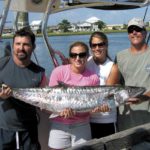
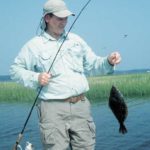
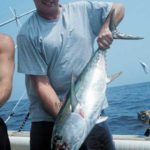
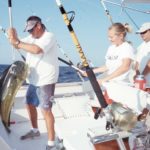



Be the first to comment